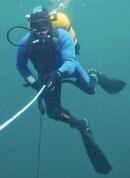Not 22lbs it doesn’t, all neoprene is not the same, there are different densities and linings. I use 16lbs with my Elios 7mm long John + 7mm jacket with hood in cold water. No problem swimming up steel twins. Photo coming to the deco station in an O’Dare high density wetsuit 7mm long John + 7mm jacket and hood no wing and no weight belt , no problem swimming up the loss of buoyancy on the bottom at 57m. Perfect balance at 10 foot stop with 50bar.That is misinformation. Your wetsuit loses buoyancy at depth: basic Boyle's Law calculation. Most of the buoyancy (and warmth) of neoprene comes from the gas bubbles permanently trapped inside the rubber. As the ambient pressure increases with depth, those bubbles are compressed and suffer a proportional loss of buoyancy. This is true regardless of the type of neoprene used.
If you don't believe me then put an empty wetsuit and some weights into a mesh bag and take it down to 100 ft (30m). Use a fish scale to see how much lift it loses at depth.
To answer the original question, yes it is pretty much impossible to have a fully balanced rig with a thick wetsuit. With a single tank most of us can probably swim it up if we have to, but it's safer and more comfortable to use a proper shell drysuit.
I understand where the problem comes from with soft stretchy neoprene in xxxlarge sizes. It’s not a good idea to make divers helpless, they should be able to overcome a bit of weight or buoyancy. Neutral is nice but you shouldn’t drown or get bent if you’re not.





